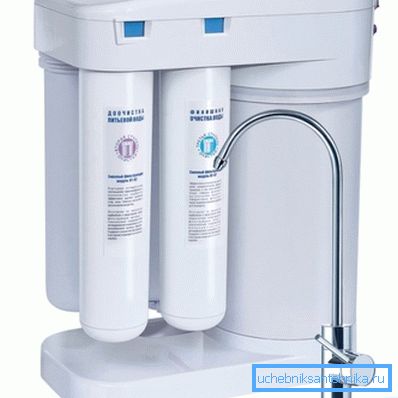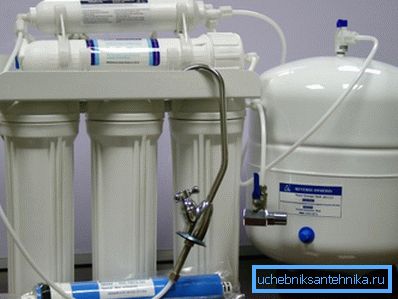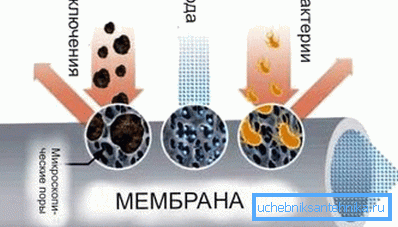Choosing a water purifier for washing: review of the
Are you interested in whether it is possible to significantly improve the quality of tap water with your own hands using the available equipment? It turns out that there is such an opportunity and as a result tap water will be almost as clean as bottled water.
In order to significantly improve the quality of water from the kitchen faucet, you need special filtering equipment with the possibility of installation under the kitchen sink. The location of the device for water purification is not accidental, since, being under the sink, the filter occupies a minimum of free storage space. Again, the location under the sink greatly simplifies the connection of the device to the water supply.

Criteria for selecting filtering equipment

In order to decide which filter is better, you need to take into account a number of features inherent in this equipment.
Among the selection criteria, we note such moments as:
- the ability to install their own hands;
- the dimensions of the filter device;
- performance and throughput;
- the level of complexity of maintenance;
- The frequency of replacement of consumables (filter cartridges) and their price;
- the price of the device itself.
After we have decided on the selection criteria, we will consider the main types of filtering equipment and determine their main advantages and disadvantages.
Devices for cleaning medium

The filtering equipment of the average degree of purification is used in domestic conditions for obtaining high-grade drinking water from running tap water. In accordance with the design features, these devices can be located under the sink or on the washbasin.
The filtering equipment of an average degree of cleaning is subdivided into 2 and 3-step modifications with one or several flasks.
- two-stage devices work according to the following scheme: Stage 1 - carrying out mechanical cleaning, and Stage 2 - cleaning by means of a layer of activated carbon.
- three-stage devices work about as well as the previous devices, but the water goes through an additional 3rd stage of purification.
For finer filtration, layers of ion exchange resin or extruded activated carbon are used. Moreover, such filtering devices may contain backfilling enriched with silver, hexametaphosphate crystals and other active additives.
Important: Equipment presented in these categories, flow and designed to work with cartridges. Thus, when the life of the cartridge expires, you must immediately replace it with a new analog.
Among the advantages of choosing devices of moderate purity, we note the following:
- long service life;
- possibility of effective cleaning, both from mechanical impurities, and from organochlorine compounds;
- ease of changing your own cartridges;
- compact dimensions of the installation.
Among the operational flaws, we note:
- the inability to clean water from viruses and bacteria;
- inability to retain dissolved nitrates, chlorides and fluorides.
- incomplete retention of pesticides, iron, manganese, heavy metals, trichloromethane, oil-containing products and salts.
- high price in comparison with filters-jugs.
Devices for cleaning the highest degree

High-purity filters are a wide range of devices based on reverse osmosis systems and ultrafiltration membranes.
Purification by reverse osmosis is performed using a reverse osmosis membrane. The water thus purified is subjected to ultrafiltration.
Water passing through the ultrafiltration membrane leaves a large amount of contaminants on the latter. The layer of pollution during regular cleaning increases. There are membranes that need to be opened and washed regularly, and there are membranes with a self-cleaning function, where impurities do not accumulate, but are discharged into the sewer system.
Important: Water purified by the osmosis system is potentially dangerous to humans, as it does not contain the necessary amount of minerals. As a result of prolonged use of such water, the necessary minerals are washed out and the essential minerals are practically not restored.
In reverse osmosis filters, the following cleaning steps are used:
- the first step (pre-cleaning of suspensions and mechanical impurities up to 30 microns in size) is carried out by means of a cartridge filled with twisted or foamed polypropylene;
- the second stage is carried out through a layer of activated carbon that holds organochlorine compounds and gases;
- the third stage (tertiary treatment of suspended matter with a size of up to 5 Mkm) is carried out by means of a layer of compressed activated carbon;
- the fourth stage of purification is performed by means of a thin-film reverse osmosis membrane with a pore diameter of not more than 1 nanometer;
- the fifth stage of cleaning is carried out by a coal post filter.
Among the advantages of this equipment, we note the following:
- possibility of cleaning up to the state of distilled water;
- simplicity and ease of use;
- retention of bacteria, viruses and heavy metals.
Among the significant drawbacks we note:
- large dimensions and, as a result, the occupied space under the entire sink;
- the absence of mineral compounds in the water at the outlet and, as a consequence, the unsuitability of water for long-term use in food;
- low device performance;
- frequent need to replace consumables;
- high price.
Devices with ultrafiltration membrane

Devices with ultrafiltration membranes can also be installed under the kitchen sink and operated in flow-through mode. Perhaps this is the system that offers the highest quality level of cleanliness, as water passes through five stages of purification, starting with the retention of mechanical suspensions and ending with bactericidal treatment.

Unlike devices operating on the principle of reverse osmosis, an ultrafiltration membrane made of a tubular composite does not remove the minerals necessary for the human body from water. Therefore, the water obtained from such plants can be applied on a daily basis without any restrictions.

The operation of such installations demonstrates the following advantages:
- high level of cleaning;
- small dimensions in comparison with the sizes of reverse osmosis filters;
- the ability to effectively remove bacteria, viruses and heavy metals without retention of mineral salts;
- high performance in comparison with the previously listed counterparts.
Among the drawbacks, we note the inability to control water hardness and high cost.
Important: In addition to the listed categories of filtering equipment, nano-filters appear on the market from time to time, providing the highest degree of water purification combined with improved taste. But the price of this equipment is such that such filters are available to very few buyers.
Conclusion
Now that you know what the operating instructions of the filtering equipment are, you can choose the device that will meet your needs for clean water. More useful information can be found by watching the video in this article.